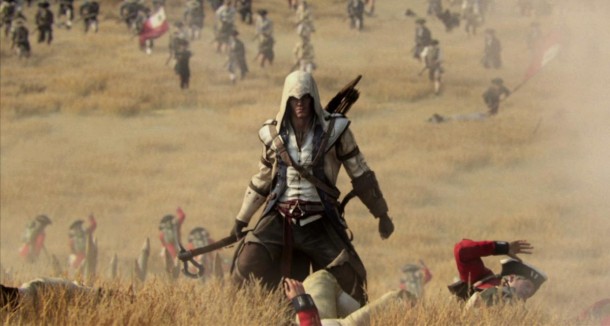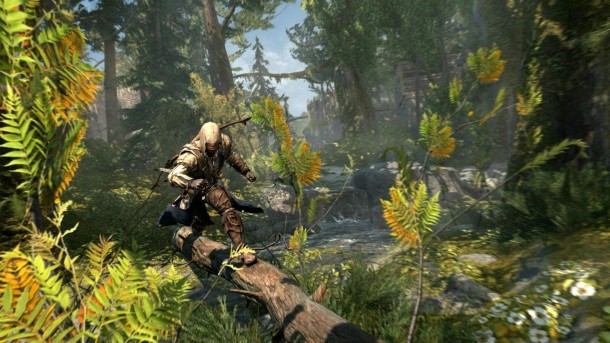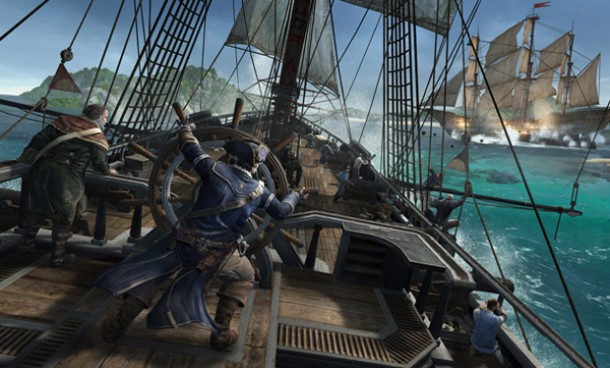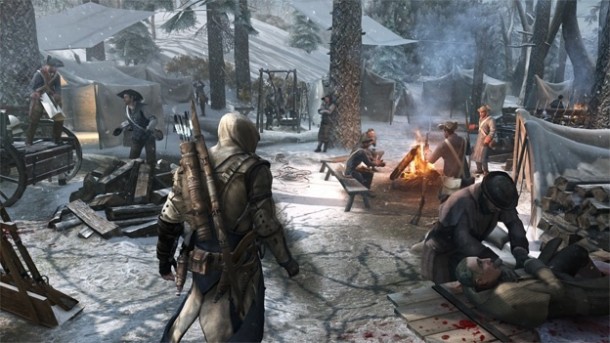
A fine line exists between balance and war. The Assassin’s Creed franchise has always been about the struggle between the Assassin Order and the Knights Templar: Is peace obtained through freedom? Or is it obtained through control and subjugation? Take a look any functioning government today, and you’ll probably find that this dichotomy is at its best when both freedom and order co-exist.
You kind of want the opposite in a game. When developers design a game and fill it with content, one hopes that each design choice puts more good into the game than bad. This exact struggle exists within Assassin’s Creed 3.
For every positive thing I noticed, there was something negative to accompany it — and not vice versa. Unfortunately, this relationship does not reciprocate as there are some flaws that often go unanswered by any redeeming qualities.
Assassin’s Creed 3 brings some new blood to the franchise as Desmond jumps into in Colonial American and relives the life of his half-Native American, half-British ancestor, Connor. Aside from some major developments in Desmond’s story, Connor’s story is pretty standard for Assassin’s Creed-fare; Connor is driven by revenge and guided by justice. Though unlike his predecessor, Ezio, I never grew attached to him. Granted, Ezio had three games and has had more than enough time to show me growth in his journeys. I never found Connor to be as likable. At his best, Connor’s feelings seem to be unchanging, with his morals and motivation set in stone. At his worst, he comes off as stubborn and naive — maybe even a brat at times. I felt as though he went through the game without seeing the big picture regarding the conflict between the Assassins and Templars.

Aside from the main character, the environment in Assassin’s Creed is also completely new and refreshing. I had just finished Revelations this summer and each city was beginning to look like a photocopy of a photocopy of a photocopy of every city Ezio’s ever been in.
With Colonial America and a new assassin at my fingertips, I was immediately given access to an open world that was as lush and lively as it was expansive. Some of the environments — I’m looking at you, Frontier — were almost too large. While traveling from one place to another, I could have hunted and tracked game to keep myself occupied and my hidden blade moist. But the game never really does a good job of explaining why I should be hunting and skinning animals. More on this later.
And sure. I could have also rode a horse when going from one mission to another. But traveling on horseback on the frontier isn’t fun either. With a large environment and limited help on the HUD, there was no way for me to tell which route was the best way to take while on horseback or even if the road I was on was going to take me to my destination. New to the HUD was a floating mission icon that told me how many meters away I was from the waypoint I marked on the map. The problem is that God only knew what trees, rivers, rocks, and other horse-hostile obstacles lay in between if I wanted to approach it directly. Too often, I’d come across a stream that was too deep for my horse to cross or a small rise of rocks that my horse wouldn’t jump off of.

The game also boasts a new fast travel system, but this comes a day late and a dollar short. If I was in the middle of the Frontier and wanted to go to Boston, I’d open my map and select Boston on the Frontier page of the map, bringing me to a loading screen. Upon leaving the loading screen, I would find myself at the edge of the frontier that leads me to Boston. Convenient enough, but guess what happens when I exit the frontier? Yup. Another load screen.
At the close-range, however, moving from one place to another is smooth. The new environment was taken into account as Connor is free to run through treetops and slide beneath fallen tree trunks. The terrain also provides tall grass to hide in, which allows you to walk (read: sneak) and stay hidden at the same time.
The climbing and parkour elements of the game aren’t completely flawless, though. On the frontier, synchronization viewpoints are now trees which are, at times, painful to climb. On more than one occassion, I’ve died repeatedly, putting in multiple attempts at climbing one tree to access a viewpoint. I would often be close to the top of a tree, see a row of branches that I clearly had to monkey bar-climb across, and get no response when pushing forward on the analog stick. The fact that the path was clear to me and all Connor could do was swing back and forth or leap to his death was infuriating. Climbing trees to synchronize areas of the world map is a great idea. But what’s the point if it doesn’t work as it should?

Generally, a large part of what makes this game difficult to completely enjoy is the fact that contains a lot of content. But the game does a poor job of explaining the significance of each available task that’s out there. When I tried to get involved, I spent a lot of time asking myself “Why am I doing this?” and “How do I go about doing that?” I found that it was easy for me to go through the game without finding an answer to these questions.
But maybe that’s a good thing too.
I was free to get as involved in the world as I wanted to, and the game never punished me for sitting out on some missions. The bad thing is that when I did try to get involved in side-missions, they were often not fun. For instance, a whole class of missions — the navel missions — give Connor control of a huge ship (think a pirate ship). The ship is an up-gradable, hulking, slow-moving mass of wood armed with canons that isn’t particularly fun to control. These missions made me long for Ezio’s hang-gliding sequences in Brotherhood. And I hated them.

In addition to maintaining my ship, I was also tasked with maintaining my homestead and crafting items. I was never explicitly told why this was necessary, so it never sucked me in. On top of that, I found that the game did a poor job of explaining how the homestead and crafting system worked, so I rarely went out of my way to complete these missions.
Other optional activities seemed like good ideas that were executed poorly. Tracking and hunting the wildlife on the frontier seems like a great idea given the historical context of the game, but it never felt engaging. Hunting peaceful animals involved dropping bait near a bush, hiding in that bush, and sneaking behind the animal for the kill. Sometimes it involved finding a clue on the terrain and setting a trap there (which amounts to just using an item). Going for deadlier game consisted of completing simple quick-time events when they became hostile. Since I was never compelled to hunt, I decided to stay away because I was never told why it was important to hunt anyway.
Again, all of this was fine by me since I was able to complete the campaign with no problem. It was just disappointing because there was all this content in the game and none of it seemed particularly appealing.

The multiplayer component is as fun as I remember in Assassin’s Creed: Brotherhood. The game types that are provided vary in complexity and are worth your time. My only issue with the multiplayer is that the UI is difficult to navigate. I once accidentally chose to do a tutorial mission and couldn’t figure out how to back out until I gave up and started the tutorial and quit.
It should be noted that there are some moments in Assassin’s Creed 3 that seem to be concentrated sources of frustration and have no redeeming qualities. Some missions involve chasing characters on foot. These missions turn out to be the worst I’ve ever experienced as the requirements involved in not failing the mission seemed too demanding. Climbing on buildings and approaching a target during a chase via rooftop often seemed hopeless as it took away some precious time and lengthened the distance between me and my mark. Going on foot meant you had to stay clear of any walls and objects as it was easy for Connor to “stick” to a wall and climb it when all you wanted to do was make a sharp turn around a corner. On another occasion I actually caught up to the character I was chasing, to the point where I was right next to him for several seconds. Unfortunately, the command to take him down never popped up and he got away.
This leads us to the bugs. In addition to climbing those frustrating trees and commands not popping up during chases, I encountered various instances when the game just didn’t seem to behave as it should. The lack of polish on this game was often surprising. Sometimes, I’d dispatch a group of enemies and find that one of them had left behind a floating musket. Other times, I found that the enemy AI was acting strangely. Suspicious enemies would often not return to their usual patrol after failing to find me, leaving me in a bush with no where to go without being seen.

Playing through this game was insulting at times because every time I found myself doing something that wasn’t fun, it was as if the game winked at me saying, “Hey, I’m Assassin’s Creed 3! Shouldn’t that be enough?”
If you focus on the story, Assassin’s Creed 3 is an important game to the franchise and that alone is enough to play it if you’re a fan of the series. The game offers new experiences that fit well within the context of the Colonial America. With respect to the narrative, Assassin’s Creed 3 does some interesting things that feel unique and make the game successful (as far as story-telling goes, anyway).
However, its downfall lies in this struggle between the good and the bad that exists within the gameplay. Whenever something new and interesting was presented to me, there was often a flaw there that only served as a distraction and a source of frustration. Unfortunately, some of the flaws in the game often go unanswered.
I also the question the optional missions in the game as they weren’t enjoyable or engaging. Perhaps the biggest problem here is that I’m talking about Assassin’s Creed 3. If you’ve been following along for a number of titles, you’re fairly invested. And rightfully so because it’s a narrative success. Just don’t be surprised if some design choices and lack of polish fail immerse you.
This game should have been better. The title “Assassin’s Creed 3″ deserved better.
This review is based on a copy of the game for the Xbox 360 purchased by the reviewer.


3 Comments